Read My Lips
Cannon Fodder
Theory and Setup
Results
Conclusions
More articles
Discuss this article at

The Wadcutter Question
Taking photos initially left me even more perplexed about why short, parallel feed lips came into vogue. The photos show wadcutters benefitting from fully-tapered feed lips; in fact, everything seemed to do better out of USGI style magazines. The long taper let the cartridges rise up gradually, which brought a smaller section of the bullet's nose in contact with the frame ramp and minimized the influence of meplat geometry on the feeding process. Lifting the round higher also meant the cartridge's angle upon entering the chamber was a lot less dramatic. Why would anybody want to mess with success like this?
The answer didn't come until I hit the range with the magazines and a selection of ammunition. Shooting FMJ ammunition through the USGI magazines was an amazing experience (see below), but I encountered a jam when loading the same magazine with Golden Sabers. A live round was chambered, but another cartridge double-fed into its base.
Here's what I think happened. Under recoil, all cartridges walk forward in the magazine due to their inertia holding them in place as the gun snaps backward. When the magazine has tapered feed lips, "forward" also means "up" for the round on top. Golden Sabers have the longest overall length of all the hollowpoints tested, but they're still notably shorter than the shortest ball ammo examined. This lets the shorter cartridges rise forward and up far enough to slip free of the lips when the slide slams back. Because the GI feed lips keep control of the cartridge longer than other designs, this must let it move far enough so that when jarred loose it just hops into the chamber.
This problem wouldn't happen with parallel feed lips becaue they keep cartridges at the same height even if they walk forward. Provided the round is longe enough that it can't escape the feed lips, normal extractor engagement will occur.
That left just one question: What's to stop hybrid feed lip magazines from encountering the same problem as the full-taper mags? Hybrids sport the same taper initially; however, they release early. The same problem of a round rising high enough to escape could still occur, but the escaping round might not be far enough forward to guarantee landing in the chamber, and thus could pop out of the feed lips and escape the ejection port, leaving the next round down to chamber normally. This finally explained something I'd seen before: the occasional live round in the pile of spent brass.
The mystery of the wadcutter lips had been answered to my satisfaction. Short, parallel feed lips are a way to avoid doublefeeds when using cartridges with short overall lengths.
However, shortly after publishing the above account, I received a PM from a fellow on the M1991.org forums with the handle 1944Colt, who pointed out some problems with my explanation of the feed failures, forcing a revision of the above text. He also offered his recollection of the transition to wadcutter feed lips from USGI magazines, which makes a lot more sense than my earlier conclusions, especially in light of some old photos I turned up.
First, take a look at a cartridge being fed from a magazine with USGI feed lips:
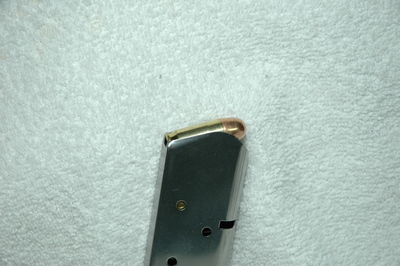
Cartridge fully seated in USGI magazine.
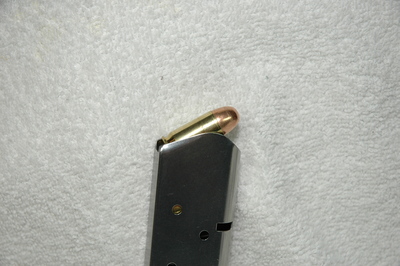
Cartridge moving forward and canting up.
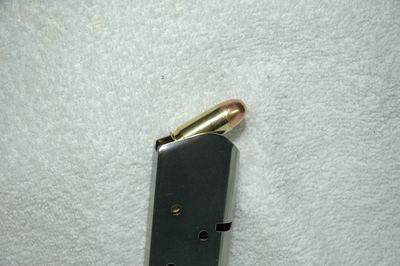
Note the high angle at this point in feeding.
Per 1944Colt, when wadcutters were introduced to guns using GI mags, they would end up tilting upward while still being controlled by the lips. Because the cartridge was shorter, it would jam into the barrel hood and lock up the gun. Moving to wadcutter lips changed the feed to look more like this:
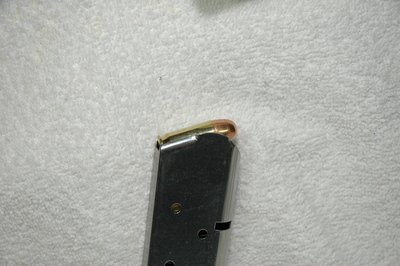
Cartridge fully seated in wadcutter magazine.
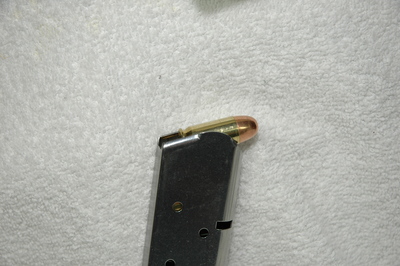
Cartridge starting to move. Note low angle.
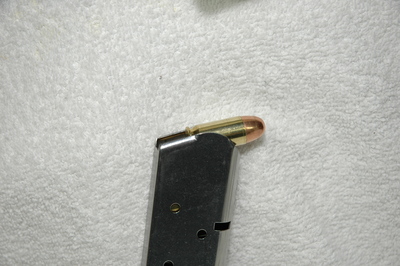
Cartridge continues to feed, but the angle stays consistent.
By the time this magazine lets the round tilt up and escape, its nose will be well into the chamber and it will be (hopefully) too late for a wadcutter to jam up the gun.
This makes a lot of sense, which it should: 1944Colt was there to see the transition. So many thanks to him for pointing me in the right direction and providing a historically correct explanation to supplement my own theory.
A Magical Combo
My favorite discovery to come out of this whole experiment was the performance of USGI feed lips with ball ammo. The rounded profile of FMJ bullets works perfectly with the angles of the full-length feed lips to produce an unbelievably smooth feed. Chambering a round feels like you're dropping the slide on an empty chamber.
Even better, control over the cartridge is absolute. When taking photos, I discovered that it was impossible to push the slide forward slowly enough to misfeed the round. Momentum was never a part of feeding, so the entire process is controlled solely by geometry. To put it another way, the slide can be under-lubed, undersprung, or just plain dirty, but as long as it is physically capable of returning to battery, it will not jam. This is pretty much the Platonic ideal of controlled feed principles--which is only appropriate, seeing as how John Browning wrote the book on controlled feed in handguns.
Such well-controlled feeding produced one unanticipated side-effect: My groups shrank when using ball ammo in USGI mags. The cartridges were making it to the chamber with enough reproducibility in their motion that it knocked a healthy 25% off my group sizes. I refused to believe it until after I'd gone back and forth between magazines several times, but it was there.
As a result of my experience testing the USGI-style feed lips, I've decided to change my carry ammo from Golden Sabers in hybrid feed lip magaziness to ball ammo in USGI mags. The terminal ballistics may not be as good, but I'll gladly surrender that for the feed reliability and accuracy improvements demonstrated by this classic cartridge/magazine combo.
Monotony of the Modern Hollowpoint
I went to some effort to photograph a variety of self-defense hollowpoints, but for the most part there was very little difference in the way they fed.
In retrospect, this is hardly surprising. All of the hollowpoints are designed to feed reliably in handguns and expand on impact. These design constraints guarantee that when independent companies try to maximize the reliability of both feeding and expansion, the results will be fairly similar. There's also the fact that the 1911's feed design, when correctly implemented, acts to minimize variations in bullet shape and length.
In the end, the photography showed how differences in feed lip geometry affected cartridge chambering under ideal conditions, but only range testing showed that the interior of an operating firearm is not an ideal place to be. Should I ever accumulate the masochistic tendencies required to do another analysis of this type, it needs to look at feeding of cartridges that have migrated forward under recoil.
Until then, I hope this article is useful as-is. Feel free to send an email if you have questions or think some sections could benefit from clarification.
Thanks for stopping by.
email: hidi.projects at gmail.com